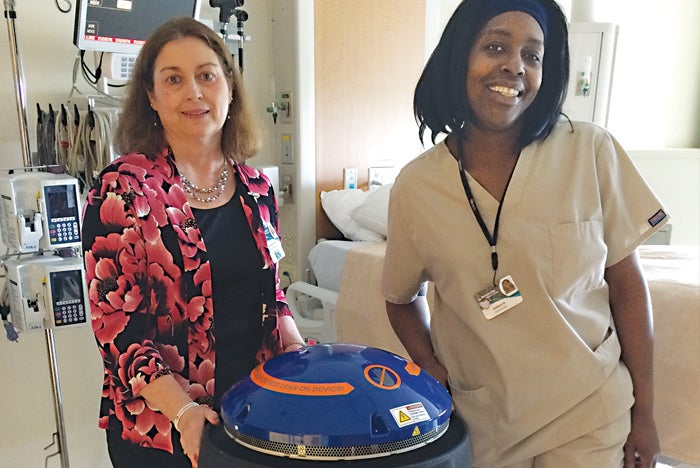Hospital uses robots to fight infection

Riverside Medical Center has deployed two UV robots in its facility to help lower HAI rates.
Image courtesy of Riverside Medical Center
Riverside Medical Center is known for its commitment to patient care, and has received many accolades attesting to the organization’s capabilities. The medical center is part of a fully integrated health care system serving patients throughout the Illinois counties of Kankakee, Iroquois, Will, Grundy and beyond.
Riverside Medical Center provides a full scope of inpatient and outpatient care and is a nationally recognized, award-winning Level II trauma hospital with nationally leading programs in heart care, cancer care, neurosurgery and orthopedics.
The 312-bed hospital is a nine-time recipient of the Watson Health Top 100 Hospitals designation, has earned Magnet status from the American Nurses Credentialing Center’s Magnet Recognition Program and is a Truven Health 50 Top Cardiovascular Hospital.
The medical center’s numerous recognitions are borne from its commitment to continuous self-improvement, and that commitment isn’t limited to clinical care. In fact, Riverside Medical Center boasts low health care-associated infection rates and recently has turned to advanced technology to drive those numbers even lower.
As hospitals look for new and innovative ways to battle deadly pathogens and kill multidrug-resistant organisms that can endanger patients and hospital employees, Riverside Medical Center invested in state-of-the-art room disinfection robots to stop superbugs in their tracks.
The medical center chose Xenex’s patented Full Spectrum, pulsed xenon ultraviolet (UV) room-disinfection system for many reasons, including its speed and ease of use. Now considered part of the hospital’s environmental standard of care, the robots’ work is paying off.
Since deploying two Xenex LightStrike Germ-Zapping Robots, Riverside has seen 27 percent reductions in Clostridium difficile, methicillin-resistant Staphylococcus aureus and Vancomycin-resistant enterococci rates facilitywide, and a 65 percent reduction in infection rates in its intensive care unit.
“The microorganisms that cause infections are getting smarter and becoming antibiotic-resistant, which is why we need new weapons like the LightStrike robot to destroy them before they pose a threat to patients and our employees,” says Martha Bouk, infection preventionist at Riverside Medical Center.
“Riverside already had very low infection rates, but our goal is zero infections,” she continues. “I am proud that since we implemented two Xenex robots, we have seen significant infection-rate reductions. Use of the LightStrike system enhances the hospital’s already thorough processes for cleaning rooms and killing the pathogens that cause infections. We want to go above and beyond for our patients, and the two disinfection robots are helping us take cleanliness to the next level.”
The LightStrike Germ-Zapping Robots can disinfect an entire patient room in 20 minutes or less. Users can access comprehensive reports from a cloud-based system to track their use and ensure consistent protocol.
Riverside’s environmental services team uses the two portable robots, named Albert and Clean Victoria, to disinfect more than 30 rooms per day in its intensive care unit, pediatric floor, medical-surgical unit and operating rooms.
The robots emit intense pulses of xenon UV light to quickly disinfect rooms by destroying the microscopic pathogens that may have been missed during the manual cleaning process.
Since deploying the two robots, Riverside Medical Center has earned another accolade as a Xenex Visionary Hospital in recognition of its innovation and success in infection prevention and outstanding patient care.
These Visionary Hospitals are recognized for their efforts to make patient safety a top priority; seek and implement technologies with multiple proven outcomes published in peer-reviewed publications; follow manufacturer-recommended best practices; publicize and share results to improve best practices for all hospitals; and openly share their data for public benefit.

